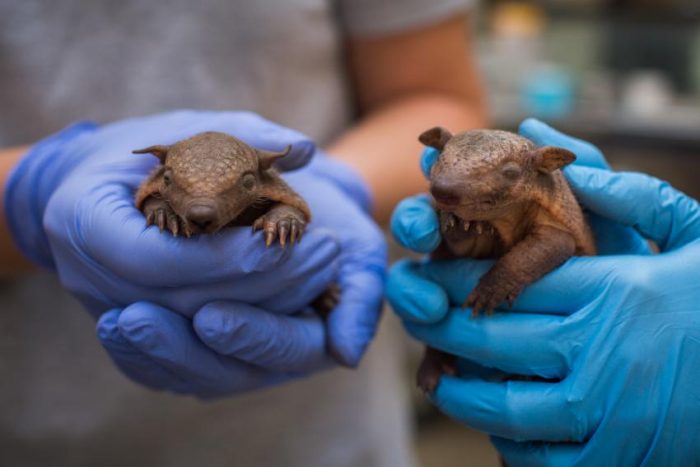All babies are beautiful—even the hairy, screaming ones
The Zoo recently celebrated the arrival of three new members of endangered species—a dama gazelle born Aug.30 and two hairy screaming armadillos born Aug. 11.
[Ed. note: No laughing. Armadillos have a hard enough time being adorable without being shamed for their hairy screaming.]

This critically endangered dama gazelle was born Aug. 30, 2017 at the National Zoo’s Cheetah Conservation Station. (Photo by Gil Myers)
After a five-year hiatus, Cheetah Conservation Station keepers at the Smithsonian’s National Zoo are celebrating the birth of a critically endangered dama gazelle. The male calf was born in an off-exhibit enclosure Aug. 30 to 10-year-old mother Adara and 3-year-old father Edem. Keepers continue to closely monitor the calf, which has been observed nursing regularly, exploring his environment and behaving normally. He is also steadily gaining weight, growing from 12 pounds at 1 day old to 15½ pounds at 5 days old. Animal care staff are allowing Adara and her calf time to bond, so it will be several weeks before visitors can view him at the dama gazelle habitat. This is the fourth calf for Adara but the first for Edem.
Edem arrived at the Zoo in July 2016 from the Smithsonian Conservation Biology Institute (SCBI) following a breeding recommendation from the Association of Zoos and Aquariums’ Species Survival Plan (SSP). The SSP scientists determine which animals to breed by considering their genetic makeup, nutritional and social needs, temperament and overall health. Visitors can see Edem and two other adult female dama gazelles, Zafirah and Fahima, at the Cheetah Conservation Station. The Zoo will provide updates on the calf on Facebook, Instagram and Twitter.
Native to Chad, Mali and Niger, Dama gazelles are listed as critically endangered by the International Union for Conservation of Nature. Less than 500 Dama gazelles remain in the wild due to habitat loss from human and livestock expansion, hunting and drought. SCBI conducts veterinary and reproductive research in order to maintain Dama gazelle populations.

Keepers hold two screaming hairy armadillo pups born at the Smithsonian’s National Zoo. The pups are the first ever born at the Zoo. (Photo Roshan Patel/Smithsonian’s National Zoo)
Two rare screaming hairy armadillo pups were born Aug. 11, the first ever born at the Zoo. They are still spending all of their time in their nest, and their eyes have not opened yet, but the bony plates that cover their bodies like armor are already visible with very fine hairs. At their last weigh-in, the pups were 144 grams and 159 grams. It is still too early to determine if they are male or female.
The pups’ parents, Amber and Dylan Walter, were recommended to breed by the Association of Zoos and Aquariums’ Screaming Hairy Armadillo Species Survival Plan. These are the first pups for both parents. Visitors will be able to see the pups at the Zoo after they have grown larger and have acclimated to their enclosure.
Screaming hairy armadillos are native to South America and are listed as a species of “least concern” by the International Union for Conservation of Nature. They get their name from the squealing noise they emit if they are threatened and the larger amount of hair they have compared to other armadillo species. At less than 2 pounds fully grown, the screaming hairy armadillo is the smallest of the three species of armadillos.
Posted: 7 September 2017
-
Categories:
Science and Nature , Spotlight , Zoo & Conservation Biology Institute



